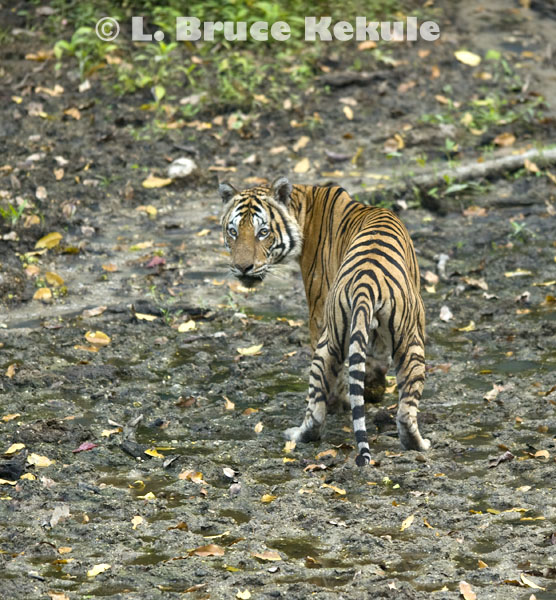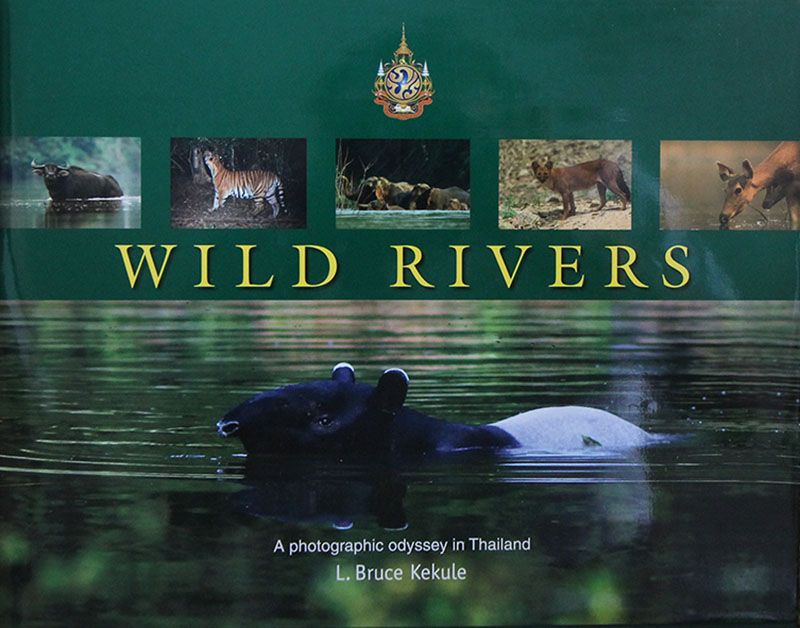Posts Tagged ‘Wild Rivers’
The River Runs Wild…!
THIS POST IS THE SECOND IN A SERIES OF WILDLIFE STORIES THAT WERE PUBLISHED IN THE BANGKOK POST. IT IS ABOUT THE FIRST EDITION OF MY THIRD BOOK TITLED ‘WILD RIVERS’
Photographic book focuses through the lens of Thai national heritage on five rivers
By: PANYAPORN PRUKSAKIT
A culmination of 12 years work and including a selection of more than 300 photographs, Bruce Kekule’s Wild Rivers is truly a photographic odyssey. From the front cover, graced by the Asian tapir, an animal so rare it is considered a living fossil, one feels like this will be a truly special read. Kekule’s 20 years’ experience as a wildlife photographer, trekking and again through Thailand’s jungles, is invaluable to his epic undertaking, this his third book.
An old banteng bull and cow at a waterhole in the Western Forest Complex of Thailand
Kekule calls this a continuation of his dedication to the “Thai Natural Heritage” with Wild Rivers dedicated to His Majesty the King on his 80th birthday anniversary. On why he chose these particular rivers – the focus of this book is on fiver rivers: The Phetchaburi. Huai Kha Khaeng, Mae Klong, Khwae Noi and the Mae Ping – Kekule remarks the main reason was that they still have wildlife left, he says, as humans have been relentless in their expansion and development plans on other waterways.
Having lived in Thailand for over 40 years, he says that these rivers and the surrounding jungles are some of his favorite places in the country. A rather spiritual man, he recalls how the inspiration for his series of wildlife photography books came to him in a dream. Kekule’s passion for his career of choice is evident – one of his favorite quotes is by the Chinese philosopher Confucius, that one should choose a job you love and you will never have to work a day in your life.
An Oriental Dwarf Kingfisher in Kaeng Krachan National Park, Southwest Thailand
From the opening pages of Wild Rivers, it is clear that Kekule not only seeks the natural beauty of Thailand’s rivers with the reader, but also to inform and educate about these “natural treasures”, as he calls them. As Kekule states in his forward, “without water, there would be no life.” The book begins with a history of Thailand’s formation, and the importance of Thailand’s rivers – what Kekule calls “the lifeblood of the nation”…(as) plants, animals and humans carry out (their) daily lives dependent on water.”
Kekule’s extensive experiences is evident in the clarity, sharpness and vivid colors which define all of his photographs. But what makes Kekule’s shots truly spectacular is that the animals he captures on film are truly in their natural habitat, almost unaware of his presence.
Equally as rivetingas the photographs, which fill the book is the narration from Kekule himself, about his adventures while writing the book. Entitled “notes from the field”, he tells of his encounters with rare creatures such as the king cobra. These stories are both endearing and amazing at the same time – he recalls how he “felt extremely happy at helping to save this beautiful bird of prey from dying,” upon finding an “owl going into shock from hypothermia” and using the campfire to warm-up this creature from a certain death.
Wild pig along the river in Huai Kha Khaeng Wildlife Sanctuary
Kekule seems to have had more than his fair share of luck – indeed he concedes that he has been luckier than most other wildlife photographers, in coming upon rare animals such as the Asian tapir in the daytime. They are primarily nocturnal and hardly seen in the day, let alone photographed with good light. But he believes strongly in the “spirits of the forest”, whom he believes guide and help him. He writes how he pays his respects to the spirits – always before eating.”
However, Kekule’s career as a wildlife photographer has not been without its occupational hazards. He recalls in his book how he “became ill with the deadly Plasmodium falciparum (celebral malaria) that almost killed [him].” Kekule states that only a “medical procedure practiced here in Thailand for patients with severe malaria called a blood exchange transfusion” saved him. While he comments that he was lucky to survive”, even this experience has not kept him from capturing the wildlife of Thailand. However, he now takes some wise precautions that he did not previously adhere to, such as not photographing in the monsoon season.
Wild Rivers – 1st Edition dedicated to His Majesty the King on his 80th birthday anniversary
Kekule states how he will continue with his career for as long as he “can hold a camera and walk”, such is his determination. The most gripping and urgent message of Wild Rivers is found in the penultimate section of the book, entitled “Wildlife in Peril: Dangers threatening the natural world”. Kekule writes about how Thailand’s ecosystems are being progressively destroyed by encroachment, poachers, the black market and the traditional Asian medicine trade. He also writes how education and aid for local village Thais and hill tribe people is needed as middlemen “flash money at the people who are mostly poor and easily persuaded to break the law in order to feed this voracious [black market] trade.” Kekule outlines a step-by-step plan for the government, for “taking care of the natural resources” of Thailand, which included suggestions about budgets and addressing grassroots problems.
Kekule’s love of Thailand as a nation, and the setting for his wildlife photography adventures, is evident in every page of Wild Rivers. He hopes that his books will serve as part of education, which must be implemented in Thai schools to change the mentality towards wildlife and nature, and promote their conservation rather than their destruction. The stunning beauty of Kekule’s book and its important message can certainly not go unnoticed, if only because of the great artistry it showcases. But perhaps the reader can also take away Kekule’s message that “all humans have a right to exist, but unfortunately, not at the expense of the natural world.”
Published in the Bangkok Post’s Outlook Section on November 10, 2008. The photos shown were actually used in the newspaper article when it was published.
LAST OF WILDLIFE TRIOLOGY
THIS POST IS THE THIRD IN A SERIES OF WILDLIFE STORIES THAT WERE PUBLISHED IN THE BANGKOK POST. WRITTEN BY USNISA SUKHSVASTI
LAST OF WILDLIFE TRIOLOGY
Male Indochinese tiger at a water hole in the Western Forest Complex
Wild Rivers: A Photographic Odyssey in Thailand is the third in a series of wildlife books — the first two were Wildlife in the Kingdom of Thailand and Thailand’s Natural Heritage – by L. Bruce Kekule, respected wildlife photographer and long time resident of Thailand. His books follow a pattern; First is an English-language edition, followed by a Thai language one.
Wild Rivers (1st Edition) was published in 2008, as dedication to His Majesty the King on the auspicious occasion of his 80th birthday, and the Thai edition (2011) recently out at the same time as the second-edition of the English version, dedicated to His Majesty the King on his 84th birthday, with the aim of sharing the beauty of the country’s natural heritage and its wildlife with the Thai people.
Wild Water Buffalo in the Huai Kha Khaeng River
The book covers six of Thailand’s major waterways: The Phetchaburi River, Khlong Saeng River (a new addition to the first edition), Huai Kha Khaeng, Mae Klong River, Khwae Noi River and the Mae Ping River.
The introduction describes the geographical locations of each river, emphasizing as always the importance of preserving these watersheds and the habitat for resident wildlife.
Black-and-red broadbill in Kaeng Krachan National Park
Each river is illustrated with photographs that he has collected from his forays into the wild over the past 12 years, allowing readers to admire the country’s wild animals in their natural habitat.
The book also includes a chapter on Thailand’s nature photographers where 1o Thai photographers and one foreign photographer have shared some of their most cherished images.
In the ‘Wildlife Photography’ chapter, Kekule shares tips and personal experiences gained from his decades in the field, his choice of equipment, the need for patience, the art of stealth, camera techniques, and even computer skills. He also mentions the hazards and dangers of being in the field, not only threats from large animals but also from the tiniest of creatures like ticks, ants and mosquitoes…!
He ends with a plea for nature conservation in ‘Wildlife in Peril’ to create awareness among readers to the diminishing numbers of animals in the wild due to human ignorance or greed.
Wild Rivers – 2nd Edition dedicated to His Majesty the King on his 84th (7th Cycle) birthday
Wild Rivers – Thai Version (1st Edition) also dedicated to His Majesty the King on his 84th (7th Cycle) birthday
Readers can be sure of a visually pleasing read. Wild Rivers received a gold medal for the “Best in Sheet-fed Offset” and another gold award for “Best 4-color Printing” at the Thai Printing Association’s 4th Thai Print Awards in 2008.
The Thai version titled ‘Sai Natee Haeng Pong Prai was translated by Capt. Araya Amrapala, PhD.
Note: The photos shown here were actually used in the newspaper article when it was published.










